| 1 |
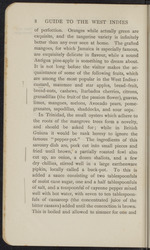 |
“...fruit of the passion flower), guavas,
limes, mangoes, melons, Avocado pears, pome-
granates, sapodillas, shaddocks, and sour sops.
In Trinidad, the small oysters which adhere to
the roots of the mangrove trees form a novelty,
and should be asked for; while in British
Guiana it would be rank heresy to ignore the
famous “pepper-pot.” The ingredients of this
savoury dish are, pork cut into small pieces and
fried until brown, a partially roasted fowl also
cut up, an onion, a dozen shallots, and a few
dry chillies, stirred well in a large earthenware
pipkin, locally called a buck-pot. To this is
added a sauce consisting of two tablespoonfuls
of moist cane sugar, one and a half tablespoonfuls
of salt, and a teaspoonful of cayenne pepper mixed
well with hot water, with seven to ten tablespoon-
fuls of cassareep (the concentrated juice of the
bitter cassava) added until the concoction is brown.
This is boiled and allowed to simmer for one and...”
|
|
| 2 |
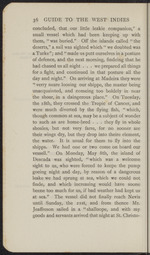 |
“...things
for a fight, and continued in that posture all the
day and night.” On arriving at Madeira they were
“ verry neare loosing our shippe, the master being
unacquainted, and comeing too boldely in near
the shoar, in a daingerous place.” On Tuesday,
the 18th, they crossed the Tropic of Cancer, and
were much diverted by the flying fish, “which,
though common at sea, may be a subject of wonder
to such as are home-bred . . . they fly in whole
shoales, but not very farre, for no sooner are
their wings dry, but they drop into theire element,
the water. It is usual for them to fly into the
shipps. We had one or two come on board our
vessell.” On Monday, May 8th, the island of
Descada was sighted, “which was a welcome
sight to us, who were forced to keepe the pump
goeing night and day, by reason of a dangerous
leake we had sprung at sea, which we could not
finde, and which increasing would have soone
beene too much for us, if bad weather had kept us
at sea.” The vessel did not finally reach Nevis
until...”
|
|
| 3 |
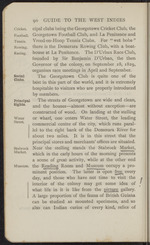 |
“...Football Club, and La Penitence and
Vreed-en-Hoop Tennis Clubs. For “wet bobs”
there is the Demerara Rowing Club, with a boat-
house at La Penitence. The D’Urban Race Club,
founded by Sir Benjamin D’Urban, the then
Governor of the colony, on September 28, 1829,
organises race meetings in April and September.
The Georgetown Club is quite one of the
best in this part of the world, and it is extremely
hospitable to visitors who are properly introduced
by members.
The streets of Georgetown are wide and clean,
and the houses—almost. without exception—are
constructed of wood. On landing at the stelling
or wharf, one enters Water Street, the leading
commercial centre of the city, which runs paral-
lel to the right bank of the Demerara River for
about two miles. It is in this street that the
principal stores and merchants’ offices are situated.
Near the stelling stands the Stabroek Market,
which in the early hours of the morning presents
a scene of great activity, while at the other end
the Reading Room...”
|
|
| 4 |
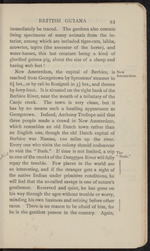 |
“...are included tiger-cats, labba,
acowries, tapirs (the ancestor of the horse), and
water-hasses, this last creature being a kind of
glorified guinea-pig, about the size of a sheep and
having web feet!
New Amsterdam, the capital of Berbice, is New
reached from Georgetown by Sprostons’ steamer in Arnsterdam-
6| hrs., or by rail to Rosignol in 3^ hrs., and thence
by ferry-boat. It is situated on the right bank of the
Berbice River, near the mouth of a tributary of the
Canje creek. The town is very clean, but it
has by no means such a bustling appearance as
Georgetown. Indeed, Anthony Trollope said that
three people made a crowd in New Amsterdam,
which resembles an old Dutch town rather than
an English one, though the old Dutch capital of
Berbice was Nassau, 100 miles up the river.
Every one who visits the colony should endeavour
^to visit the “ Bush.” If time is not limited, a trip The
to one of the creeks of the Demerara River will fully " Bush-”
repay the trouble. Few places in the world are...”
|
|
| 5 |
 |
“...112 GUIDE TO THE WEST INDIES
Coaches. Mail coaches run between Ewarton and Dry
Harbour (42 miles, 6£ hours) on Monday, Wed-
nesday, and Friday; returning Tuesday, Thursday,
and Saturday; and between Montego Bay and
Lucea (25 miles, 4 hours), fare 8s.; Williamsfield
and Mandeville (5 miles, 1 hour), fare 2s. 6d.;
Santa Cruz and Balaclava (16 miles, 3 hours 5
mins.), fare 6s.; Black River and Ipswich (18
miles, 3 hours 5 mins.), fare 6s.; and Savanna-
la-Mar and Montpelier (22 miles, 4J hours), fare
Livery 6s., daily. There are several livery stables in
Stables. Kingston, including those of Harold Bolton, W.
G. Clark, and A. Clough. The general charge for
carriages for long distances is £1 per day. On
extended tours, arrangements can be made for a
charge to include the cost of feeding the driver (is.
6d. per day) and horses (a charge varying accord-
ing to the market prices of fodder). Double
buggies for shopping in Kingston and St. Andrew’s
can be had for 6s. per hour, and saddle ponies...”
|
|
| 6 |
 |
“...are only given to
indicate the time taken between each port, and
inquiries as to the times of departure should be
made at the offices of the company, 8 Port Royal
Street:—
Leave Kingston . Monday evening.
Arrive Alligator Pond . 6 a.m. Tuesday.
» Black River 10 A.M. „
99 Sav.-la-Mar 3 p-m- .»
99 Lucea 6 a.m. Wednesday.
99 Montego Bay IO A.M. „
99 Falmouth . 2 P.M. „
99 Dry Harbour 6 P.M. „
99 St. Ann’s Bay . 11 a.m. Thursday.
99 Port Maria 2 P.M* ,,
99 Port Antonio 7 P.M. „
99 Morant Bay 6 a.m. Friday.
99 Port Morant Noon „
Leave Port Maria 8 a.m. Saturday.
Arrive Ocho Rios Noon „
99 St. Ann’s Bay . 2 P.M. ,,
‘99 Dry Harbour S P-M- »
99 Rio Bueno 9 a.m. Monday.
99 Falmouth . II A.M. „ H....”
|
|
| 7 |
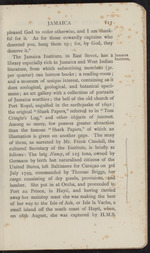 |
“...in “Tom
Cringle’s Log,” and other objects of interest.
Among so many, few possess greater attraction
than the famous “Shark Papers,” of which an
illustration is given on another page. The story
of them, as narrated by Mr. Frank Cundall, the
cultured Secretary of the Institute, is briefly as
follows: The brig Nancy, of 125 tons, owned by
Germans by birth but naturalised citizens of the
United States, left Baltimore for Curasao on 3rd
July 1799, commanded by Thomas Briggs, her
cargo consisting of dry goods, provisions, and
lumber. She put in at Oruba, and proceeded to
Port au Prince, in Hayti, and having carried
away her maintop mast she was making the best
of her way to the Isle of Ash, or Isle la Vache, a
small island off the south coast of Hayti, when,
on 28th August, she was captured by H.M.S....”
|
|
| 8 |
 |
“...TRINIDAD
*45
Basin.
afternoon’s drive. The reservoirs, which are
scrupulously clean and are surrounded by bright-
coloured crotons and oleanders and ferns, are
by no means unpicturesque. The Blue Basin The Blue
at Diego Martin is 9 miles from Port of Spain;
three hours by carriage there and back. The
beginning of the drive is through the interesting
East Indian village of Peru, and thence up the
Diego Martin valley. At one part the valley
opens out into a flat plain, which formerly used
to be under sugar canes, but is now for the most
part quite uncultivated. The plain has an evil
reputation, having been the scene of no less
than four blood-curdling murders, the last being
when a priest was brutally murdered and was
found tied to a tree. At the head of the valley
conveyances stop, and visitors proceed afoot up
a winding mountain path for about half a mile.
The Blue Basin is a small lake, forty or fifty yards
in diameter, into which a waterfall precipitates
itself in a slanting direction...”
|
|
| 9 |
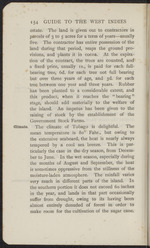 |
“...one year and three years. Rubber
has been planted to a considerable extent, and
this product, when it reaches the “ bearing ”
stage, should add materially to the welfare of
the island. An impetus has been given to the
raising of stock by the establishment of the
Government Stock Farms.
Climate. The climate of Tobago is delightful. The
mean temperature is 80° Fahr., but owing to
the extensive seaboard, the heat is nearly always
tempered by a cool sea breeze. This is par-
ticularly the case in the dry season, from Decem-
ber to June. In the wet season, especially during
the months of August and September, the heat
is sometimes oppressive from the stillness of the
moisture-laden atmosphere. The rainfall varies
very much in different parts of the island. In
the southern portion it does not exceed 60 inches
in the year, and lands in that part occasionally
suffer from drought, owing to its having been
almost entirely denuded of forest in order to
make room for the cultivation of the sugar cane....”
|
|
| 10 |
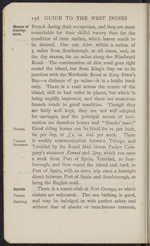 |
“...Means of
Convey-
ance.
Horses.
Coastal
Steamers.
Sports.
Tennis.
Bathing.
158 GUIDE TO THE WEST INDIES
French during their occupation, and they are more
remarkable for their skilful tracery than for the
condition of their surface, which leaves much to
be desired. One can drive within a radius of
5 miles from Scarborough at all times, and, in
the dry season, for 20 miles along the Windward
Road. The continuation of this road goes right
round the island, but from King’s Bay on to its
junction with the Northside Road at King Peter’s
Bay—a distance of 32 miles—it is a bridle track
only. There is a road across the centre of the
island, still in bad order in places, but which is
being rapidly improved, and there are numerous
branch roads in good condition. Though they
are fairly well kept, they are not well adapted
for carriages, and the principal means of loco-
motion are therefore horses and “ Shanks’ mare.”
Good riding horses can be hired for 2s. per hour,
6s. per day, or jQi, os. rod. per...”
|
|
| 11 |
 |
“...other common
purposes, such as the maintenance of a lunatic
asylum, and also for quarantine, &c. A common
audit system was instituted in 1889. Grenada has
an Executive Council and a Legislative Council
consisting of six official members, besides the
Governor, and seven unofficial members nomi-
nated by the Crown. The unofficial members
hold their seats for six years from the date of
their appointment.
St. George’s.—The Home Hotel in Young and
Monckton Streets, within fifty yards of the wharf,
is clean and comfortable. It is built in the
Italian style, with rooms opening on to galleries
overlooking a courtyard. The tariff of charges is
very moderate—R.L.A. 2s. 6d., Pension 8s. 4d.
per day. At the Grand Êtang there is a Govern-
ment Rest House and a small Sanatorium con-...”
|
|
| 12 |
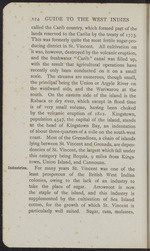 |
“...This was formerly quite the most fertile sugar-pro-
ducing district in St. Vincent. All cultivation on
it was, however, destroyed by the volcanic eruption,
and the freshwater “Carib” canal was filled up,
with the result that agricultural operations have
recently only been conducted on it on a small
scale. The streams are numerous, though small,
the principal being the Union or Argyle River on
the windward side, and the Wariwarou at the
south. On the eastern side of the island is the
Rabaca or dry river, which except in flood time
is of very small volume, having been choked
by the volcanic eruption of 1812. Kingstown,
population 4547, the capital of the island, stands
at the head of Kingstown Bay, an indentation
of about three-quarters of a mile on the south-west
coast. Most of the Grenadines, a chain of islands
lying between St. Vincent and Grenada, are depen-
dencies of St. Vincent, the largest which fall under
this category being Bequia, 9 miles from Kings-
town, Union Island, and Cannouan...”
|
|
| 13 |
 |
“...and for other game, 10s.
The New Club, near Government House, “is
noted for its hospitality, and the principal London
papers and magazines can be seen at the Public
Library, which is situated in High Street, near
the landing-place.
The town of St. John’s, at the head of the
harbour of the same name, used to be defended
by Goat Hill Fort on the south, and on the north
by Fort James, while Rat Island, which is con-
nected with Antigua by a narrow isthmus, was
also fortified. The streets are very clean and the
houses are nearly all made of wood painted
a dazzling white. The Anglican Cathedral stands
on rising ground at the head of the town. It
is a handsome stone fabric, with a fagade ter-
minating at either end in octagonal domed towers,
and replaces an inferior building wrecked by
/...”
|
|
| 14 |
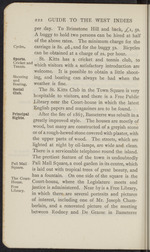 |
“...Kitts Club in the Town Square is very
hospitable to visitors, and there is a Free Public
Library near the Court-house in which the latest
English papers and magazines are to be found.
Principal After the fire of 1867, Basseterre was rebuilt in a
Sights
greatly improved style. The houses are mostly of
wood, but many are constructed of a greyish stone
or of a rough-hewed stone covered with plaster, with
the upper parts of wood. The streets, which are
lighted at night by oil-lamps, are wide and clean.
There is a serviceable telephone round the island.
The prettiest feature of the town is undoubtedly
Pall Mall Pall Mall Square, a cool garden in its centre, which
Square. js laid, out with tropical trees of great beauty, and
has a fountain. On one side of the square is the
Ine Court- „ , . ^
House. Court-house, where the Legislature meets and
Library Just'ce *s administered. Near by is a Free Library,
in which there are several portraits and pictures
of interest, including one of Mr. Joseph Cham-...”
|
|
| 15 |
 |
“...has three groups of mountains, the
highest elevation being the Soufrière (3002 feet)
in the southern part of the island. The hills rise
in steady slopes from the sea, and are cultivated
to a height of 1500 feet. The cultivated land
is mainly on the western and south-eastern sides.
A natural forest clothes the summits of the two
main ranges, and as a consequence streams are
plentiful; but the northern hills being almost
denuded of trees, the land in that part of the
island is for the most part dry and unprofitable.
Plymouth, the chief town (population 1461), stands
on the south-west coast, and has an open road-...”
|
|
| 16 |
 |
“...232 GUIDE TO THE WEST INDIES
The principal exports in the year 1904—5 were
as follows:—
Lime-juice and limes . . . ^7803
Sugar (429 tons) .... 3007
Cotton 1380
Climate. The climate of Montserrat is comparatively
cool and very healthy, there being no indigenous
malaria in the island, owing, probably, to the fact
that it is so well drained. Though the northern part
is rather dry as the result of deforestation, the south
has an abundance of water. The mean annual
temperature is 78° Fahr., the rainfall from 40 to 80
inches, and the death rate only 16 per thousand.
History. Montserrat was discovered by Columbus in 1493,
on his second voyage, and named by him after
a mountain near Barcelona in Spain. It was
first colonised by the English under Sir Thomas
Warner in 1632, but was captured from them by
the French in 1664. In 1668 it was restored to
England, in whose possession it remained until
1782, when it capitulated to the French. It was
again ceded to England in 1784, and since that
date it...”
|
|
| 17 |
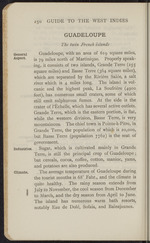 |
“... in
Grande Terre, the population of which is 20,000,
but Basse Terre (population 7762) is the seat of
government.
Sugar, which is cultivated mainly in Grande
Terre, is still the principal crop of Guadeloupe;
but cereals, cocoa, coffee, cotton, manioc, yams,
and potatoes are also produced.
The average temperature of Guadeloupe during
the tourist months is 68° Fahr., and the climate is
quite healthy. The rainy season extends from
July to November, the cool season from December
to March, and the dry season from April to June.
The island has numerous warm bath resorts,
notably Eau de Dolé, Sofaia, and Bainsjaunes....”
|
|
| 18 |
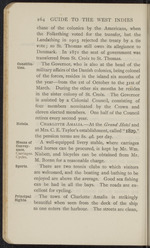 |
“...be procured, is kept by Mr. Wm.
Carriages. Nisbett, and bicycles can be obtained from Mr.
Cycles.
M. Bornn for a reasonable charge.
Sports. There are two tennis clubs to which visitors
are welcomed, and the boating and bathing to be
enjoyed are above the average. Good sea fishing
can be had in all the bays. The roads are ex-
cellent for cycling.
Principal The town of Charlotte Amalia is strikingly
Sghts. beautjfui wben seen from the deck of the ship
as one enters the harbour. The streets are clean,...”
|
|
| 19 |
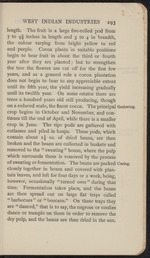 |
“...which surrounds them is removed by the process
of sweating or fermentation. The beans are packed Curing,
closely together in boxes and covered with plan-
tain leaves, and left for four days or a week, being,
however, occasionally “ turned over ” during that
time. Fermentation takes place, and the beans
are then spread out on large flat trays called
“ barbecues ” or “ boucans.” On these trays they
are “ danced,” that is to say, the negroes or coolies
dance or trample on them in order to remove the
dry pulp, and the beans are then dried in the sun....”
|
|
| 20 |
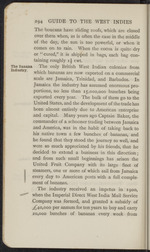 |
“...294 GUIDE TO THE WEST INDIES
The boucans have sliding roofs, which are closed
over them when, as is often the case in the middle
of the day, the sun is too powerful, or when it
comes on to rain. When the cocoa is quite dry
or “cured,” it is shipped in bags, each bag con-
taining roughly i £ cwt.
The Banana The only British West Indian colonies from
^ which bananas are now exported on a commercial
scale are Jamaica, Trinidad, and Barbados. In
Jamaica the industry has assumed enormous pro-
portions, no less than 15,000,000 bunches being
exported every year. The bulk of them go to the
United States, and the development of the trade has
been almost entirely due to American enterprise
and capital. Many years ago Captain Baker, the
commander of a schooner trading between Jamaica
and America, was in the habit of taking back to
his native town a few bunches of bananas, and
he found that they stood the journey so well, and
were so much appreciated by his friends, that he
decided to extend a business...”
|
|
